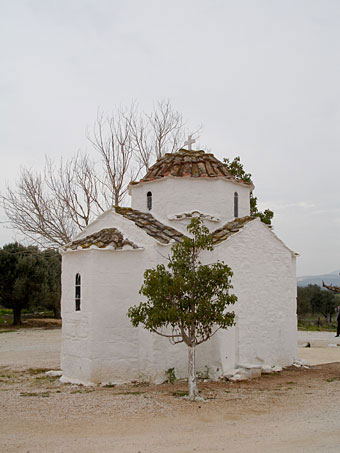
 |
 |
 |
 |
Type: Free - Cross
Date: 12th century
Description:
In the north of Markopoulo lies the elegant, small church of Panagia Baramba. It is a free cross-plan church with no narthex. It was initially dated to the 13th century, but more recent studies have placed it to the 12th century (Bouras). The stonework presents interest given that the lower parts of the walls consist of spolia, the upper ones of massive porous stones, while close to the cross-arms it is made of perfect cloisonné masonry. The Crucifixion is portrayed on the arch of the western wall. Despite the fact that it is scarcely detectable, the scene is beautiful and expressive, reminding us of the Crucifixion in Daphni. The synthesis is plain and includes a few figures in reserved postures. Ioannis’ posture is very interesting. He is not portrayed in his usual pose with the one hand on his cheek supporting his inclined head, but with a closed Gospel in his left hand looking at the viewer. Ioannis is portrayed here as the historian who sees and testifies. This wall painting is dated to the Palaeologan period, shortly before the Fall of Constantinople. The remnants of the wall paintings discovered on the drum are very interesting, as well. There are four figures, apparently prophets, depicted in luxurious garments embroidered with pearls and patterns of lily flowers, rosettes and adjoined circles inscribed with crosses, characteristic of the 12th – 13th century painting. Unfortunately, we cannot identify the figures, in order to reach conclusions regarding the choice of the prophets. On the one hand no inscription has been preserved, on the other hand it is impossible to recognize the remains of the text in the open eilitarion that the last prophet towards the south holds. The church is not mentioned in historical sources. The toponym Barabas, by which the church of Panagia is called, is probably of Frankish origin and is related to the Frankish rulers’ activity in this area of Attica after 1204. Many similar toponyms are found in the wider area of Mesogeia. For instance, we mention Klissia Fragkou, Palati, Frati etc.
Bouras C. – Kaloyeropoulou A.-Andreadi R., Churches of Attica, p. 153-154, plan XV-XVI, pl.. 125-130




